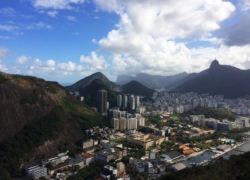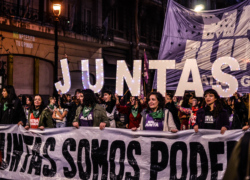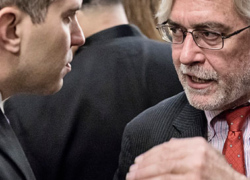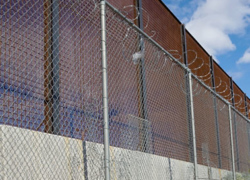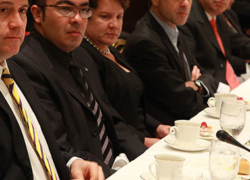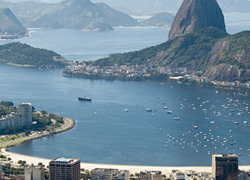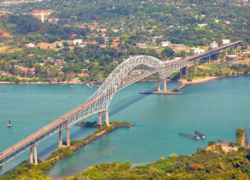Hugo Chávez’s speech to the United Nations General Assembly on September 24, 2009, did not receive much attention. The speech was notably more restrained than his famous address on the same occasion three years earlier, in which the Venezuelan president had called George W. Bush the “devil” and referred to the “smell of sulfur.” This time Chávez was forced to depart from his usual, incendiary script because of Barack Obama’s favorable image and his preference for engagement—”We will extend a hand if you are willing to unclench your fist,” the US president had declared in his inaugural address. Indeed, Chávez said the smell of sulfur had been replaced by “the smell of hope.”
Nonetheless, Chávez—ever resourceful—hinted at what might become a common view regarding Obama’s approach toward Latin America and the Caribbean. He referred to “two Obamas,” one projecting a friendly, conciliatory image, and the other adhering to the course of Obama’s predecessors, who typically treated the region as the “backyard” of the United States. Chávez raised doubts about whether old practices and concepts would in fact give way to more genuine and equitable cooperation. His speech referred directly to three issues that caused friction in hemispheric relations in 2009: Cuba policy, the US military presence in Colombia, and the Honduras crisis.
The past year has actually seen relatively little substantive change on a number of longstanding disputes. And toward the end of 2009, inter-American strains were further aggravated by the sensitive question of Iran’s growing involvement in the region. The November visit of Iranian President Mahmoud Ahmadinejad to Venezuela, Bolivia, and, most significantly, Brazil coincided with deepening concerns in Washington and the international community about Iran’s nuclear program.
The implications of the visit were serious enough that Secretary of State Hillary Clinton warned Latin American countries on December 11 that “if people want to flirt with Iran, they should take a look at what the consequences might well be for them.” These words had a familiar ring, and predictably elicited a response from Chávez about “threats” leveled by the US government.
Also disconcerting, if not unexpected, for many Latin Americans was the absence of a sustained, high-level focus on the region during the first year of the Obama administration. Granted, the new president was inundated from the outset, and many other issues—from the economic crisis to health reform to changing conditions in Afghanistan—understandably took precedence. But Latin Americans were dismayed that a new assistant secretary for Western Hemisphere affairs was not in place until the end of November, and that Latin American policy degenerated into partisan bickering over issues like Honduras. Today, signs of frustration are unmistakable in Washington and in many Latin American capitals, despite Obama’s immense personal appeal and the continued promise of a more productive partnership.
The Mood Swing
The fifth Summit of the Americas, involving every democratically elected head of state in the region, was fortuitously scheduled less than three months after Obama’s historic inauguration. The summit in Trinidad and Tobago provided the new US president with an introduction to the region’s leaders, political idiosyncrasies, and complex challenges. Obama had never been south of the border before, though he did stop in Mexico on his way to the summit. His prior meetings with Mexican President Felipe Calderón and Brazilian President Luiz Inácio Lula da Silva were well orchestrated and entirely appropriate, given the importance of both countries.
Not surprisingly, the spotlight at the summit was on Obama, who aroused considerable curiosity. He performed in exemplary fashion, setting a refreshingly moderate tone, promising a “new beginning,” and extending a hand even to hostile leaders such as Chávez. While this overture was somewhat controversial at home, Obama showed regional leaders that he would not view the Americas in ideological terms, as a region sharply divided between friends and adversaries. Rather, Obama called for “mutual respect,” and although he was not the first US president to do so, his personal background and story lent the pledge greater credibility.
Further, Obama’s decision to close the detention facility at Guantánamo Bay, Cuba—although implementation has been bogged down—was an enormously important and positive signal to the region. Obama also acknowledged failure regarding the two principal sources of irritation in US-Latin American relations: Cuba and counternarcotics policies. He promised to work cooperatively in devising alternative approaches to these and other questions on the hemispheric agenda.
At the very least, Obama’s debut on the regional stage was highly successful in improving the mood in US–Latin American relations. Obama’s likeability contrasted sharply with his predecessor’s, significantly enhancing the favorable image of the United States. For example, according to the Pew Research Center, in Brazil last year confidence in Obama was at 76 percent, a dramatic jump from the 17 percent that Bush registered in 2008. A Latin American Barometer poll revealed an increase in the United States’ favorability from 58 percent in 2008 to 74 percent in 2009—the highest rating ever reached by the United States since the survey began in 1995.
This shift mirrors a global upward trend and represents no meager accomplishment for the new administration. Improvement in America’s image, though no substitute for substantive policy gains, is an essential step toward repairing the damage of preceding years and rebuilding trust in US foreign policy.
Along with projecting a friendlier face to the world, Obama’s other major achievement in his first year was averting a widely feared economic collapse and all of its likely repercussions. In Latin America there was enormous apprehension about how the financial crisis would affect a region that had endured more than its share of such crises (even though this time the problem originated in the United States). To its great credit, Latin America largely avoided the effects of the economic turmoil; Brazil’s quick rebound was particularly impressive.
By adopting effective economic measures, Obama in effect heeded Lula’s suggestion that the best thing the United States could do for Latin America was to put its own economic house in order. Although severe problems in the region remain, including high unemployment, the worstcase scenarios were fortunately never realized. With the notable exception of Mexico, whose economy contracted by more than 7 percent in 2009, Latin America weathered the financial crisis substantially better than most experts predicted.
The Honduras Surprise
No one expected when Obama took office that Honduras would become an important test for the administration’s new approaches toward democracy, relations with Latin American partners, and multilateral cooperation. Yet after Manuel Zelaya, the democratically elected president, was ousted by the Honduran military on June 28, a series of reactions—sometimes with comic opera qualities—ended up severely complicating US–Latin American relations.
The Obama administration’s condemnation of the coup—Zelaya’s prior unconstitutional power grab did not offset or justify such an egregious violation of the democratic order—was swift and firm. Obama said the coup was “illegal” and set a “terrible precedent.” The president was keen to be on the “right side” of this issue, to work in concert with Latin American neighbors, and try to distinguish himself from Bush, whose administration had conveyed undisguised glee after a coup temporarily removed Chávez from power in April 2002. In what turned out to be an instance of remarkable political consensus, the United States and every other country in the hemisphere adopted a punitive stance toward the de facto regime in Honduras, pressing for Zelaya’s return.
The regional consensus against the coup can be attributed to two factors in addition to the US reaction. The first is that Zelaya was a Chávez ally, which led the Venezuelan president and his supporters in the Bolivarian Alliance for the Peoples of our Americas (ALBA) to take a forceful stand. (Honduras had joined ALBA in 2008. Other ALBA members, besides Venezuela, include Cuba, Bolivia, Nicaragua, Ecuador, and a number of Caribbean nations.)
In addition, although some coups have occurred in Latin America in recent years (even military coups, such as Ecuador’s in 2000), this one touched a nerve in the region. A widely shared calculation, which turned out to be entirely incorrect, was that a unified, principled position in the hemisphere would lead to a practical solution. Honduras’s de facto government, it was believed, would be forced to succumb to sustained international pressure. As it happened, nearly everyone underestimated the government’s resistance and ability to delay, as it ran out the clock until an election that had already been scheduled for November 2009.
As the crisis dragged on, the Obama administration tried to pursue a middle ground, which provoked criticism from both sides. Washington was reluctant to impose a solution and apply the full force of trade sanctions, though the Obama administration consistently insisted on Zelaya’s return and employed some pressure on the de facto government (by withholding aid, for example). For such perceived ambivalence, Obama was criticized by some Latin American governments, such as Brazil’s, which called on Washington to exercise its disproportionate leverage to ensure Zelaya’s return. The calls for a more heavy-handed US approach seemed to irk Obama, who noted in August “the irony that the people that were complaining about the US interfering in Latin America are now complaining that we are not interfering enough.”
At the same time, the Honduras controversy quickly became mired in US domestic politics. Some congressional Democrats echoed Brazil’s sentiments. Republicans, however, were upset that Obama was pushing so vigorously for the return of Zelaya, an ally of the anti-US Chávez. They criticized what they perceived to be Zelaya’s antidemocratic conduct and lauded the de facto government’s resistance.
Republicans were particularly enraged when the Obama administration announced that it would not recognize the November 29 elections unless Zelaya presided over them. Jim DeMint, a Republican senator from South Carolina, was the most conspicuous critic of the administration’s policy, expressing his disapproval by holding up the appointments of Arturo Valenzuela as assistant secretary of state and Thomas Shannon as ambassador to Brazil. The acrimony and partisan discord in Washington were reminiscent of the cold war battles that played out regarding Central America a generation ago.
In October, with the election in Honduras fast approaching, it became increasingly clear that efforts to resolve the issue pursued by the Organization of American States (OAS) and Costa Rican President Óscar Arias were unlikely to bear fruit. The de facto Honduran government showed no sign that it would allow Zelaya (who had been holed up in the Brazilian embassy since September) to return to the presidency. The Obama administration, eager to resolve both the Honduras crisis itself and the domestic political dispute regarding Honduras that jeopardized its Latin America policy, undertook a diplomatic mission that resulted in both Honduran parties signing an accord.
According to the agreement, Zelaya could return to power with the approval of the Honduran Congress, and the November election would proceed with everyone accepting the results. Although many initially applauded the accord as a breakthrough that would end the crisis, it soon became clear that the two sides interpreted the agreement differently, leaving the deadlock unresolved.
With the accord, the Obama administration decided that it would recognize the outcome of the election, leaving as a separate matter, and one in the hands of the Honduran Congress, the question of Zelaya’s return to office. This distinction left Washington sharply at odds with other Latin American governments, which said they would recognize the election only if Zelaya were allowed to return.
Honduras’s Congress in the end withheld its approval. But the US administration reckoned that if the elections proceeded reasonably well—with the result seen as legitimate by most Hondurans—then other governments would eventually come around to recognizing and dealing with the new government. (As a result of this policy stance, DeMint lifted his hold on the appointments of Valenzuela and Shannon.)
Porfirio Lobo of Honduras’s National Party was elected the country’s next president, and some governments have already joined the United States in recognizing the outcome. In this context, prospects for a solution to the Zelaya issue appear increasingly likely, preparing the ground for Honduras to resume full diplomatic and economic relations in the hemisphere.
For the Obama administration, the crisis is instructive in several respects. While the administration quickly and properly adopted a principled and punitive stand alongside its Latin American partners, it misread conditions on the ground in Honduras, hindering a practical solution. Moreover, the administration’s on-again, off-again involvement in the crisis hampered its ability to strike the delicate balance between supporting cooperative, hemispheric approaches and trying to shape a favorable outcome.
A tight economic relationship between Honduras and the United States made it even more crucial that the United States play such a diplomatic role. Yet the Obama administration, perhaps in a rush to resolve the crisis and partly as a result of domestic political problems, ended up carrying out a policy that left its Latin American friends unhappy, both because they were not adequately consulted and because they did not endorse the terms of the accord.
Colombia Confusion
A lack of consultation and of adequate diplomatic groundwork has also strained US–Latin American relations on another key issue: an agreement between Washington and Bogotá for US access to seven Colombian bases used for combating drugs and that country’s insurgencies. The 10-year pact, news of which leaked in Colombia in August —it was signed at the end of October—has revived suspicions in South America about US military motives in the region. The announcement of the agreement, ineptly managed, struck Latin Americans as incongruous with the spirit of the Obama administration’s stated regional approach.
The agreement moved forward and reached completion through inertia—it had been in the works during the Bush administration—and it was championed by the government of Colombian President Álvaro Uribe. In Colombia it was sold as a way to ensure the country’s security in the face of potentially aggressive moves by Chávez. In Washington, the accord was driven by bureaucratic agencies, particularly the Defense Department’s Southern Command, with scant strategic or political vision. A serious review of this military cooperation pact—and how it would be perceived in Latin America—was by all accounts not undertaken with the right focus and energy.
The deal was a political gift for Chávez, giving him new ammunition for his anti-US tirades. Chávez has long used the substantial security collaboration between the United States and Colombia as evidence of a military threat to his country and as justification for his own military spending, which has included the purchase of an estimated $5 billion to $7 billion worth of arms from Russia alone.
Venezuela’s ambassador in Washington, Bernardo Álvarez, wrote in December that the agreement’s “vague provisions and questionable motivations threaten regional stability and territorial sovereignty, alter the region’s military balance, and threaten to push more of the violence and drug trafficking that is endemic to Colombia’s conflict across its borders.” Chávez has been unrelenting in his criticism, seizing on the pact to attack the Obama administration. In fact, it was predictable that the Venezuelan president, feeling increasingly encircled in the region and politically vulnerable at home, would lash out.
The Obama administration has responded by insisting that the agreement merely formalizes the existing security relationship with Colombia and does not signify an increased US military presence in the country (the current cap is 800 US military personnel and 600 private contractors) or any operation beyond Colombia’s borders. It is doubtful, given Washington’s other preoccupations and policy priorities in the region, that it has any interest whatsoever in carrying out the activities suggested by Chávez and others in Latin America.
Still, it is unclear that the new agreement was even necessary for achieving US policy goals. And even if the deal were deemed essential, it should have been accompanied by a high-level diplomatic effort and communications strategy aimed at assuaging persistent, understandable concerns among Latin American friends like Brazil about the role of the US military in the region.
Perhaps the most damaging aspect of the Colombia base agreement for US–Latin American relations has been the strong reaction registered by Brazil’s government. The Brazilians, after all, just a year ago launched the Union of South American Nations, which is modeled after the European Union and seeks to deal with defense issues as part of a wide-ranging regional agenda.
Any agreement regarding the United States and its evolving security role in South America was bound to generate suspicion and controversy, so prior consultations with senior officials of the continent’s leading power should have been a top priority. Although Brazilian criticism of the United States on this issue may have been overblown, Washington should have been able to anticipate such a reaction.
Cuba, again
As Obama quickly discovered at the summit meeting in Trinidad and Tobago, no issue unifies Latin America in its posture toward the United States as much as the decades-long US embargo against Cuba. Obama’s election to the presidency—including his victory in Florida, which has a sizeable Cuban-American community—was thought to signal a greater openness to ending the anachronistic embargo and engaging Cuba instead.
Obama fulfilled his campaign promises to lift Bush-era restrictions on travel and remittances by Cuban-Americans, and to authorize new US investments in telecommunications in Cuba. The administration renewed dialogue on migration and engaged in negotiations to establish regular postal service. The moves so far have been modest and incremental, but they clearly point to a more open-minded approach toward Cuba and a sharp departure from Bush administration policies.
Nonetheless, it is clear that lifting the embargo—as most Latin Americans have called for—remains politically unrealistic absent significant steps toward reform on Cuba’s part, such as releasing political prisoners or holding free and fair elections. And there is no indication that Cuban President Raúl Castro intends to adopt such changes any time soon. The more politically feasible step of lifting a travel ban for all Americans has some congressional momentum, but some congressional resistence as well, and the Obama administration has been cautious.
Another key development affecting US–Latin American relations was lifting Cuba’s suspension from the OAS, which had lasted 47 years. This change came at the OAS General Assembly meeting in Honduras in early June, when a resolution that set a path for Cuba’s return to the organization was unanimously approved (even though to date Cuba has shown no interest in coming back).
Although the resolution contained some political conditions and reflected a sound compromise, the process caused some irritation on both sides. Washington wanted tougher conditions, and some Latin American governments—especially the ALBA bloc—pressed for a resolution without conditions. The Obama administration preferred a more cautious, deliberate approach to an issue that in the United States remains highly charged.
The Real Agenda
The Obama administration’s pragmatic and realist foreign policy orientation has logically meant an interest in deepening relationships with the two most significant Latin American countries: Brazil and Mexico. From the outset of his administration, Obama seems to have grasped the vital importance of Brazil in helping to advance US interests and priorities in the region. Brazil, increasingly active and influential in global forums such as the Group of 20, and with aspirations to gain a seat on the United Nations Security Council, is regarded as a central player on issues such as energy, climate change, nonproliferation, and the Doha round of trade negotiations.
During Obama’s first year as president, the US-Brazil relationship regarding these and other global questions has been somewhat more productive than it has been regarding issues on the regional agenda, especially Honduras, the Colombian bases, and Cuba. Also, as mentioned, the Ahmadinejad visit to Brazil in late November provoked concern in Washington, particularly among some members of Congress. Differences on these issues highlight contrasting political realities and conflicting priorities in Washington and Brasília.
In Mexico, on the other hand, the realities of relentless crime and violence—aggravated by that country’s profound economic crisis in 2009—have only deepened Mexico’s ties with the United States. The bilateral agenda is impressively broad, encompassing issues such as trade, immigration, drugs, human rights, and the environment. To be sure, frustration remains on both sides. Washington wants the Calderón administration to push for longawaited structural reforms. Many Mexicans resent unabated US demand for drugs, a continued flow of arms and drug money into their own country, lack of progress on immigration reform, and restrictions on Mexican trucks operating north of the border.
Nonetheless, the Obama administration is building on remarkable advances in the institutionalization of this essential relationship—in the executive, legislative, and judicial branches of government—an institutionalization that has evolved in recent years and has ensured reasonably effective management of problems when they emerge. The Mexican case dramatically illustrates the pernicious consequences of organized crime throughout the Americas, much of it fueled by the drug trade. With the selection of former Seattle police chief R. Gil Kerlikowske as the head of the US Office of National Drug Control Policy, or “drug czar,” the Obama administration signaled a shift in strategy that would concentrate more resources and attention on reducing demand and consumption in the United States.
However, while widespread dissatisfaction with supply-side counternarcotics policies persists in Washington, there is still no alternative approach backed by political consensus to supplant this admittedly flawed strategy. A special commission on drug policy in the Americas, an initiative of the House Subcommittee on Western Hemisphere Affairs, will, pending Senate approval, be established to review Washington’s current antidrug approach and come up with recommendations for a more effective policy. Such a serious policy review is likely to be welcomed throughout Latin America, where a special regional commission headed by former presidents Fernando Henrique Cardoso (Brazil), Ernesto Zedillo (Mexico), and César Gaviria (Colombia) has highlighted the drug trade’s detrimental effect on the rule of law and democratic governance.
On two other matters of great concern in Latin America—immigration and trade—the Obama administration has moved slowly, if at all. Both issues are politically contentious and risky to handle. Obama and the Democrat-controlled Congress have signaled, however, that they plan to undertake comprehensive immigration reform in 2010.
The Hispanic congressional caucus in particular has applied enormous pressure on the administration to fix a broken and irrational immigration system, and to regularize the status of an estimated 12 million undocumented workers in the United States. Moving reform forward is apt to be difficult and will hinge on economic conditions and the unemployment picture. But at least there appears to be a will to pursue reform, and a strong political constituency is pushing hard for it.
On trade questions, in contrast, the Obama administration has been notably indifferent. Trade is much lower on the policy agenda than immigration, and is particularly sensitive with unions, an important Democratic Party constituency. To date, there is no indication the US Congress will soon approve a pending trade pact with Panama and particularly a more controversial deal with Colombia. The Free Trade Area of the Americas—the chief hemispheric goal that emerged from the first Summit of the Americas in 1994—is essentially moribund, with weak support in Washington and most Latin American capitals.
Tempering Expectations
Then-President Bill Clinton presided over that first summit, which was held in Miami, and which reflected considerable optimism for hemispheric cooperation. But Clinton also presided over the approval of a $1.3 billion counternarcotics assistance package in 2000, known as Plan Colombia. Whatever that program’s merits, it was fundamentally bilateral and it heavily emphasized security assistance. Predictably, it was harshly denounced and wildly unpopular throughout Latin America. Clinton, though, somehow managed to escape criticism in the region for what was regarded as a misguided effort.
Obama may face a similar challenge in Latin America. While he is likely to remain an enormously popular and appealing figure, US policies will continue to attract criticism in the region, especially in the absence of a clear, strategic concept guiding future decisions. The costs of the Honduras crisis and the US-Colombia base agreement resulted from an abiding mix of intermittent policy attention, failure to consult widely, and inability to take fully into account Latin American concerns and sensibilities.
This is not to say that more effective policy management and deeper understanding of the region would necessarily yield policy convergence. On the contrary, what is most instructive about the various episodes in US–Latin American relations during Obama’s first year in office is the extent to which sharply contrasting political realities and constraints render cooperation on a range of issues much more difficult. The fundamental task is to minimize unnecessary irritations and to identify which of the political realities are most worthy of substantial investment of diplomatic and economic resources.
In this regard, the devastating earthquake in Haiti on January 12, 2010—described by former President Clinton as “one of the great humanitarian emergencies in the history of the Americas”— presented a particularly compelling need and opportunity for high levels of US commitment, combined with regional collaboration. Although Haiti, the Western Hemisphere’s poorest country, has long been neglected and has not fit easily in any subregional group, it nonetheless illustrates the possibilities for effective multilateralism. The presence of 7,000 peacekeepers serving with a seven-year-old United Nations mission—including significant and varied Latin American representation, led by Brazil—had already marked a step forward in redressing Haiti’s traditional isolation from collective hemispheric endeavors.
The Obama administration’s notably swift and forceful response to the Haiti tragedy, and its interest in working in concert with Latin American neighbors, could help the United States recover some lost ground in inter-American relations this year, and could replenish a measure of goodwill with countries such as Brazil. Washington’s response also serves as a reminder that under some circumstances—and despite the recent emergence of exclusively Latin American groupings—the United States is uniquely suited and well-positioned to play a significant role in addressing critical regional challenges and advancing shared interests.
Nonetheless, it is important not to overstate the possible effects of the Haiti calamity for improving US–Latin American relations. Indeed, what was most striking about an ALBA meeting held in Havana in mid-December was that the pronouncements that came out of it about Obama were barely distinguishable from those aimed at Bush in preceding years. Chávez read a note from Fidel Castro, who had previously praised Obama, now saying “empire is on the offensive again. . . . under the friendly smile and African-American face of Barack Obama.” Such language may not predict behavior, and it should not stop the Obama administration from looking for ways to engage ALBA members. But it does offer a dose of realism about what can be reasonably expected from a set of governments led by
Chávez and his allies.
The continuing irritations in relations between the United States and Latin America make it all the more urgent that the Obama administration extensively consult with and even more deeply engage the most significant and largely friendly governments in the region, such as Brazil, Mexico, Chile, Colombia, and Peru—as well as some select nations like El Salvador and the Dominican Republic in too often overlooked Central America and the Caribbean.
Bolstering such ties and offering concrete reassurances of genuine partnership should be at the top of Washington’s agenda in the Americas. The critical challenge is to pursue priorities of mutual interest and to avoid fueling polarization and getting sidetracked.






